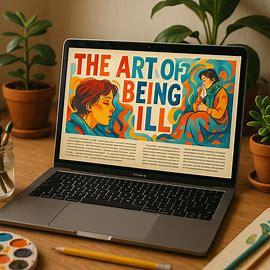Introduction
Illness often arrives uninvited, interrupting our routines, plans, and sense of control. While most people focus on the discomfort and disruption that sickness brings, there is another way to view it: as an opportunity for reflection, self-care, and inner growth.
The art of being ill involves cultivating patience, compassion, and acceptance during times of sickness. It transforms what many see as a period of weakness into a meaningful chapter of self-discovery and healing.
1. Reframing Illness as a Teacher
The first step in mastering the art of being ill is shifting your perspective. Illness is not merely an obstacle; it can be a profound teacher.
By pausing our usual fast-paced lives, sickness forces us to reflect on our physical and emotional needs. We learn humility in acknowledging our vulnerabilities and gain insight into the balance required for true well-being.
2. The Power of Acceptance
Acceptance is at the heart of the art of being ill. Too often, people push themselves to “power through” sickness or feel guilty for resting. This resistance often leads to longer recovery periods or deeper exhaustion.
Acceptance doesn’t mean surrendering to illness. Instead, it involves acknowledging your body’s needs and allowing yourself the space and time to heal. This mindset can reduce stress and help restore both physical and emotional balance.
3. Rest as a Form of Active Healing
Rest is often underestimated in modern society, where productivity is prized. However, rest is not laziness—it is an active part of the healing process.
The art of being ill reframes rest as intentional and restorative. Proper sleep, quiet reflection, and minimizing unnecessary tasks allow the body to conserve energy and focus on recovery. Far from being wasted time, rest is essential for regaining strength.
4. Tuning Into the Body’s Signals
One of the most profound lessons of the art of being ill is learning to listen to your body. Pain, fatigue, and other symptoms are signals rather than inconveniences.
By paying attention to these signals, you gain valuable insight into your overall health. This self-awareness encourages better choices—not just during sickness but also in maintaining long-term wellness.
5. Navigating the Emotional Journey
Illness can take an emotional toll, often bringing frustration, fear, or sadness. These feelings are natural responses to physical discomfort and disrupted routines.
The art of being ill encourages acknowledging and expressing these emotions rather than suppressing them. Journaling, mindful breathing, or speaking with a friend can help release emotional burdens and support mental well-being during recovery.
6. Creating a Healing Environment
Our surroundings play a crucial role in the recovery process. A peaceful environment can calm the mind and promote healing.
Practical steps aligned with the art of being ill include:
-
Keeping the space clean, uncluttered, and quiet.
-
Surrounding yourself with calming colors and natural light.
-
Incorporating soothing music or nature sounds.
-
Ensuring easy access to water, nutritious food, and essential medications.
A supportive environment reduces stress and allows the body to focus on healing.
7. Connection and Community
Illness can sometimes feel isolating, but it also opens the door for deeper connections with others. Accepting help—whether it’s a meal from a friend or emotional support from a loved one—reminds us that healing is often a collective effort.
The art of being ill involves embracing this support without guilt, recognizing that vulnerability can strengthen bonds and foster genuine compassion.
8. Holistic Healing Beyond Medicine
While medical treatment is crucial for addressing physical symptoms, holistic practices contribute to overall well-being.
Some elements of the art of being ill include:
-
Staying hydrated and eating balanced, nourishing meals.
-
Practicing gentle stretches or guided breathing exercises.
-
Using mindfulness or meditation to reduce stress.
-
Incorporating creative activities like reading, sketching, or writing to uplift the spirit.
These practices can enhance recovery and encourage a sense of agency even when physical energy is low.
9. The Lessons Hidden in Sickness
Sickness often teaches lessons that a healthy life cannot. It highlights the importance of self-care, shows us where our boundaries lie, and encourages gratitude for the times when we feel well.
Through the art of being ill, we discover that illness, while challenging, can foster resilience, empathy, and a renewed sense of purpose.
10. Practical Tips for Embracing the Art of Being Ill
Here are some practical ways to adopt this mindful approach:
-
Listen to your body: Don’t ignore warning signs.
-
Prioritize rest: Make recovery the top priority.
-
Stay connected: Accept help and share how you feel.
-
Engage in reflection: Use downtime for journaling or quiet introspection.
-
Practice gratitude: Appreciate the lessons learned during difficult times.
These practices transform illness from a passive experience into an opportunity for intentional growth and healing.
11. Carrying Wisdom Into Daily Life
One of the greatest benefits of practicing the art of being ill is that the lessons extend beyond periods of sickness.
You may develop healthier routines, become more mindful of your limits, and build resilience that helps in facing future challenges. More importantly, you may gain deeper empathy for others, having experienced your own moments of vulnerability.
Conclusion
Illness often feels like an unwelcome interruption, yet it can be a profound teacher when approached with the right mindset. The art of being ill is about embracing vulnerability, accepting help, and finding moments of reflection amid discomfort.
By slowing down, listening to the body, and nurturing emotional health, we transform sickness into an opportunity for personal growth. These experiences build resilience, compassion, and wisdom—qualities that last long after recovery.



